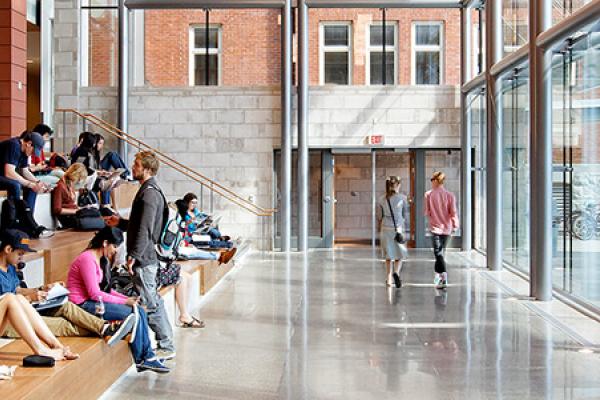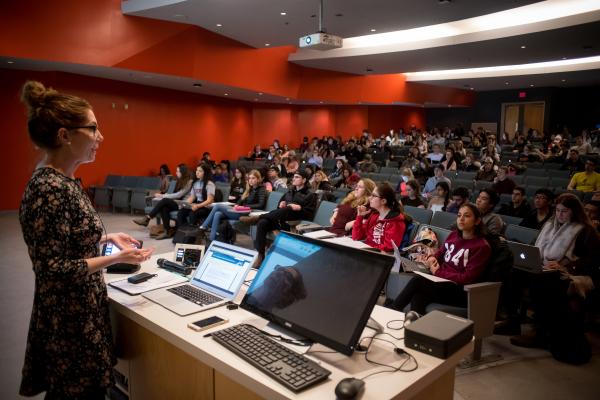NetID
When you applied to Queen’s, you were assigned a NetID – a unique network identification that allows you to access many of Queen's online services.
It is important to never share your NetID and password with anyone!
Activate or manage your NetID and password using Queen's Identity Platform. Note that Queen’s will never ask you for your NetID and password via email or phone.
Activate and Manage Your NetIDAccessing SOLUS
The SOLUS Student Centre is designed to provide you with the tools to manage all of your academic, financial, contact and admission details during - and after - your academic career at Queen's.
Visit the Office of the University Registrar's SOLUS information page for a complete list of functions and a navigation guide for the SOLUS Student Centre.
In order to login to the SOLUS Student Centre, you will be asked to provide your NetID and password.
Access SOLUS via MyQueen’sUAccessing Course Material via onQ
onQ is Queen's enterprise Learning Management System, powered by Brightspace/Desire2Learn. With onQ, you can:
- Access course content, such as videos, group work, shared files, etc.
- Communicate directly with your professor and classmates
- Collaborate and present assignment material
- Submit assignments, quizzes, and other material for evaluation
- View grades and assignment feedback
Login to onQ with your NetID and Password.
For assistance with using onQ and a complete list of its functions, visit the onQ support webpage.
Access onQAccess Free Software
Queen’s University provides all students with access to an impressive suite of collaboration and productivity tools, this includes Microsoft Office 365 tools. Examples of provided software include:
- OneDrive for Business: store your files in the cloud for access from anywhere.
- Teams: collaborate with fellow students on assignments and projects with this shared workplace.
- Word, Excel, PowerPoint, Outlook: your favourite Office applications available via browser.
- OneNote: provides a single place for keeping all of your class notes in a powerful online notebook.
- Zoom Education: a cloud-based solution for video and audio conferencing, collaboration, and online meetings
- MATLAB: a programming platform designed specifically for engineers and scientists to analyze and design systems and products
- Minecraft Education: an edition of Minecraft specifically designed for teaching and learning
Here is a full list of provided software.
Access Available Software and ToolsAdditional IT Considerations

Learning How to Use Available Software
Learn how to use the software that is available to you:
-
Microsoft Training: Links to videos, tutorials, and FAQs to learn how to use these productivity tools.
-
Microsoft Learning Tools: Microsoft Learning Tools is natively built into Microsoft 365 and Microsoft Edge applications. The immersive reader capability in Learning Tools gives users the ability to have content read aloud to them, and lets them adjust settings to break the words into syllables, adjust text size or background colors.

Communication and Collaboration Resources
Resources to help you collaborate, communicate, and learn remotely include:
-
Microsoft Office: Outlook, Word, Excel, PowerPoint, OneDrive & more - your go-to productivity app for mobile devices.
-
Microsoft Teams: Your hub for teamwork. Conversations, files (Word, PowerPoint, Excel), group calling, and apps live together in a single shared workspace.
-
Zoom: Start, join and schedule sessions; send group text, images and push-to-talk messages on mobile devices.
-
NameCoach: users can record the pronunciation of their name in an audio file, include pronunciation notes, include preferred gender pronouns and customize their audio link to aid accessibility.

Preparing Your Technology for Queen's
Consider these actions as you prepare your devices for Queen's!
Queen’s Residences provides Internet and e-mail access in your residence room – ResNet – and all you’ll need is a personal computer with a network adapter for Ethernet. If you'll be living in residence, learn how to connect to the Internet while in residence.
If you ever have trouble connecting connecting to Queen's wireless network, consider these troubleshooting tips.
Consider checking with your faculty or department for specific device or technological requirements.
Learning Remotely
As a Queen's student, you may have in-person classes, online classes, or some combination of both. If you are attending online courses, we have put together a list of resources to consider as you make your way through the course. These resources include things like group and peer evaluations, connecting with professors and teaching assistants, and course material within onQ.
onQ is Queen's enterprise Learning Management System, powered by Brightspace/Desire2Learn. With onQ, you can:
- Access course content, such as videos, group work, shared files, etc.
- Communicate directly with your professor and classmates
- Collaborate and present assignment material
- Submit assignments, quizzes, and other material for evaluation
- View grades and assignment feedback
Visit the onQ support site for students to learn more about what you can do with onQ.
As many courses move to online delivery, it's important to stay connected to peers and faculty. There are a few ways to keep in touch:
Microsoft 365
Some of your classes may be delivered using Microsoft Teams. Microsoft Teams is a collaboration tool that allows users to interact via video and audio calls and chat, share, upload, and collaborate on documents, and more. Use Microsoft Teams to:
- Attend lectures, visit virtual office hours and access a space for collaboration.
- Have impromptu or scheduled meetings with classmates with video and audio chat, screen sharing and file collaboration
Zoom
Some of your classes may be delivered using Zoom. Like Teams, Zoom allows you to attend lectures and collaborate remotely. Participants do not require an account to join meetings.
Class Groupwork
- onQ Discussions – The Discussions tool provides an area for collaboration and communication, allowing youto post, read and reply to messages on different topics.
- onQ Assignments – Use the Assignments tool to submit assignments, view rubrics and competencies, download assignments to your computer, and view grades and feedback.
- onQ Groups – Groups are used for a specific project or activity, and are a means of organizing learners within a course into a smaller unit for collaborative activities. Groups can be used to interact with the Discussions and Assignments tools.
- Microsoft Teams – You can use Microsoft Teams to share and collaborate on documents, chat over instant messaging, and have ad-hoc meetings/gatherings over audio or audio and video.
Peer Review
- Aropä – Aropä is a web-based tool that supports peer review of assignments. Aropä can be used for students to provide formative or summative feedback and/or grades to each other. There is also an additional option that allows the student feedback to be graded by students, TA's, or by an instructor.
- Feedback Fruits - Fully integrated with onQ, Feedback Fruits allows students to conduct evaluations like peer reviews and peer evaluations directly within the LMS.
Remote Proctoring
Students will be informed through their program if they will be expected to complete remotely-proctored assessments. If you have been informed that you will be completing a remotely-proctored assessment, please consult the Office of the University Registrar site for more information, including step-by-step guides, FAQs, and more.
Accessibility
- Microsoft Learning Tools – The Microsoft Learning Tools set is natively built into the Office 365 and Microsoft Edge applications. The immersive reader capability in Learning Tools gives users the ability to have content read aloud to them, and lets them adjust settings to break the words into syllables, adjust text size or background colors.
- Visit the Accessibility Hub for more information about accessibility.
Protecting Your Devices and Data from Harm
Phishing emails attempt to defraud users of their personal information. View tips on how to identify phishing emails.
IT Services strongly recommends reporting phishing, spam, and abusive emails. Learn how to report suspicious or unwanted emails.
Queen’s has introduced Multi-Factor Authentication (MFA). Multi-factor authentication adds a second layer of security, keeping your account secure even if your password is compromised.
Visit the IT Services webpage on MFA for more information on multi-factor authentication and how to enroll.
If you’re running a supported version of Windows, you’re probably already set. The latest versions of Windows have Windows Defender pre-installed.
If you have an older version of Windows or a Mac, you should investigate the best antivirus solution for your operating system. Check out the Antivirus page for more information about antivirus and your system.